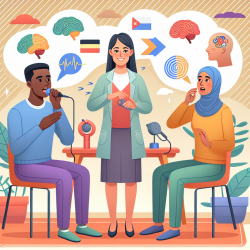Introduction
As speech-language pathologists, our goal is to create positive outcomes for children through effective interventions. A recent study on the "Community-level spillover effects of an intervention to prevent intimate partner violence and HIV transmission in rural Ethiopia" provides valuable insights into how interventions can extend their impact beyond direct participants. This blog explores how these findings can be applied to enhance speech-language pathology practices, particularly in educational settings.
Understanding Spillover Effects
The study conducted in rural Ethiopia demonstrated that interventions targeting intimate partner violence (IPV) and HIV could have significant spillover effects on the broader community. The intervention, known as Unite for a Better Life (UBL), was delivered to men, women, and couples, and its effects were measured not only on direct participants but also on indirect beneficiaries within the community. The findings revealed that even those not directly involved in the intervention experienced positive changes in behavior and attitudes, particularly when the intervention was delivered to men.
Implications for Speech-Language Pathology
In speech-language pathology, interventions are often designed to address specific communication challenges faced by children. However, the concept of spillover effects suggests that these interventions can also influence the broader educational environment. Here are some ways practitioners can harness this potential:
- Engage the Community: Just as the UBL intervention involved community members, speech-language pathologists can engage teachers, parents, and peers in the intervention process. By fostering a supportive community, the impact of interventions can extend beyond the individual child.
- Promote Collaborative Learning: Encourage group activities that involve children with communication challenges and their peers. This can facilitate the diffusion of positive communication strategies throughout the classroom.
- Utilize Peer Modeling: Similar to the role of facilitators in the UBL study, peers can serve as models for effective communication behaviors, promoting positive change among their classmates.
Encouraging Further Research
The findings from the Ethiopian study highlight the need for further research into the spillover effects of speech-language interventions. Practitioners are encouraged to explore how interventions can be designed to maximize community-level impacts. This could involve collaborating with researchers to conduct studies that measure not only the direct effects on children but also the broader influence on their educational and social environments.
Conclusion
The concept of community-level spillover effects offers a promising avenue for enhancing the impact of speech-language pathology interventions. By considering the broader context in which children learn and communicate, practitioners can design interventions that not only address individual needs but also foster a supportive and inclusive environment for all children.
To read the original research paper, please follow this link: Community-level spillover effects of an intervention to prevent intimate partner violence and HIV transmission in rural Ethiopia.










